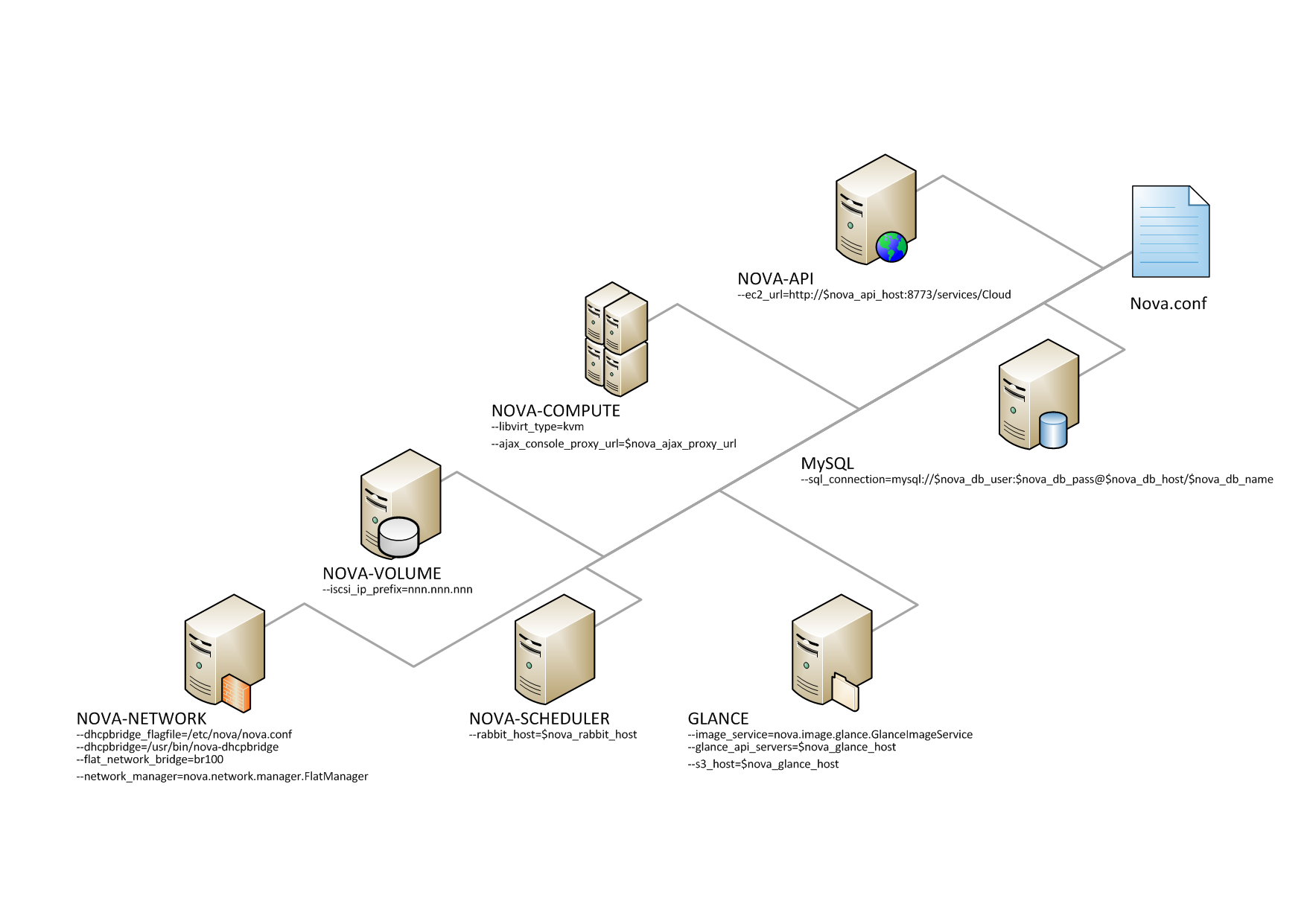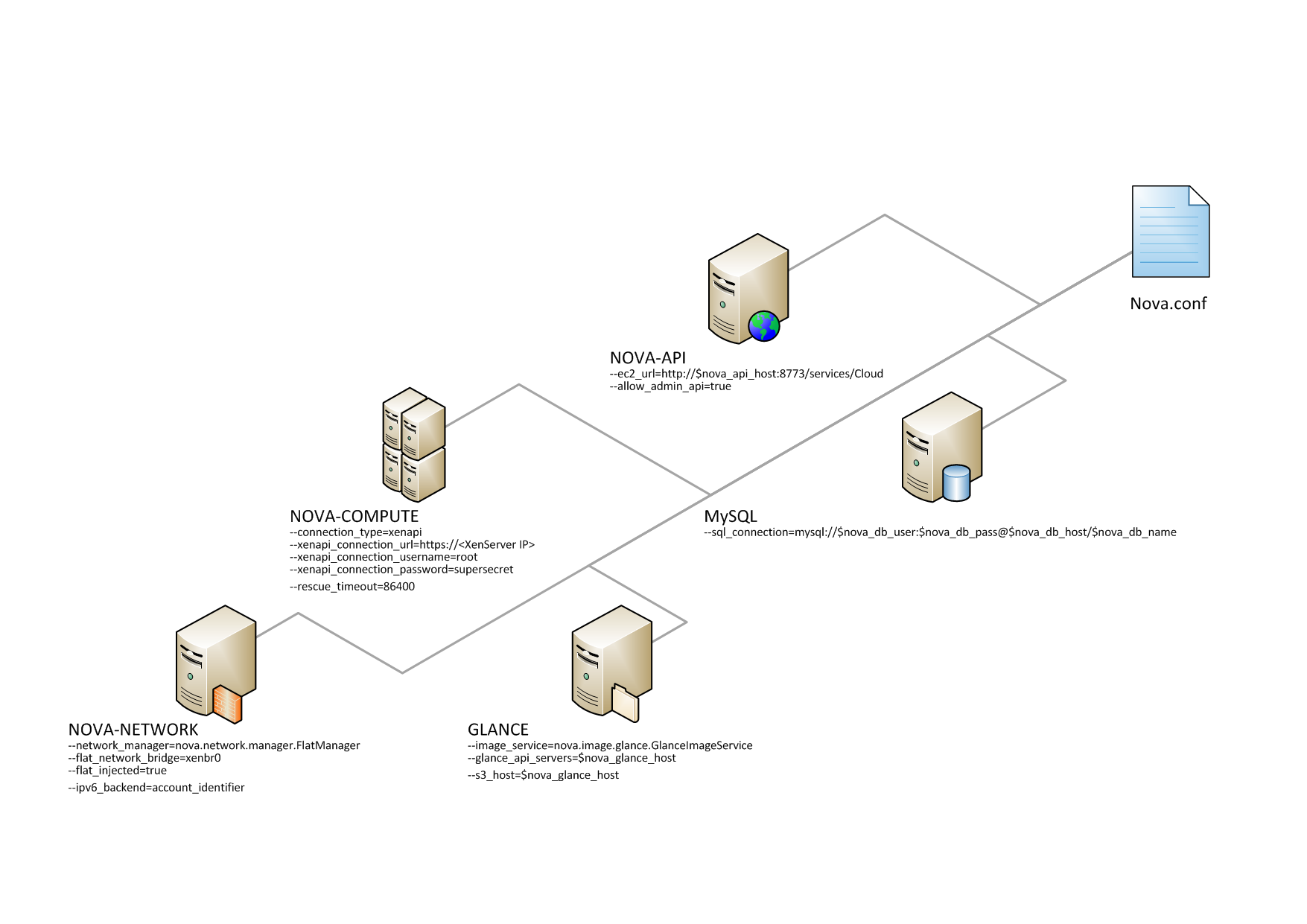The following sections describe the configuration options in
the nova.conf file. You must copy the
nova.conf file to each compute node.
The sample nova.conf files show examples
of specific configurations.
This example nova.conf file
configures a small private cloud with cloud controller
services, database server, and messaging server on the
same server. In this case, CONTROLLER_IP represents the IP
address of a central server, BRIDGE_INTERFACE represents
the bridge such as br100, the NETWORK_INTERFACE represents
an interface to your VLAN setup, and passwords are
represented as DB_PASSWORD_COMPUTE for your Compute (nova)
database password, and RABBIT PASSWORD represents the
password to your message queue installation.
[DEFAULT] # LOGS/STATE verbose=True logdir=/var/log/nova state_path=/var/lib/nova lock_path=/var/lock/nova rootwrap_config=/etc/nova/rootwrap.conf # SCHEDULER compute_scheduler_driver=nova.scheduler.filter_scheduler.FilterScheduler # VOLUMES # configured in cinder.conf # COMPUTE compute_driver=libvirt.LibvirtDriver instance_name_template=instance-%08x api_paste_config=/etc/nova/api-paste.ini # COMPUTE/APIS: if you have separate configs for separate services # this flag is required for both nova-api and nova-compute allow_resize_to_same_host=True # APIS osapi_compute_extension=nova.api.openstack.compute.contrib.standard_extensions ec2_dmz_host=192.168.206.130 s3_host=192.168.206.130 # RABBITMQ rabbit_host=192.168.206.130 # GLANCE image_service=nova.image.glance.GlanceImageService glance_api_servers=192.168.206.130:9292 # NETWORK network_manager=nova.network.manager.FlatDHCPManager force_dhcp_release=True dhcpbridge_flagfile=/etc/nova/nova.conf firewall_driver=nova.virt.libvirt.firewall.IptablesFirewallDriver # Change my_ip to match each host my_ip=192.168.206.130 public_interface=eth0 vlan_interface=eth0 flat_network_bridge=br100 flat_interface=eth0 # NOVNC CONSOLE novncproxy_base_url=http://192.168.206.130:6080/vnc_auto.html # Change vncserver_proxyclient_address and vncserver_listen to match each compute host vncserver_proxyclient_address=192.168.206.130 vncserver_listen=192.168.206.130 # AUTHENTICATION auth_strategy=keystone [keystone_authtoken] auth_host = 127.0.0.1 auth_port = 35357 auth_protocol = http admin_tenant_name = service admin_user = nova admin_password = nova signing_dirname = /tmp/keystone-signing-nova # DATABASE [database] connection=mysql://nova:yourpassword@192.168.206.130/nova # LIBVIRT [libvirt] virt_type=qemu
This example nova.conf file, from
an internal Rackspace test system, is used for
demonstrations.
[DEFAULT] # LOGS/STATE verbose=True logdir=/var/log/nova state_path=/var/lib/nova lock_path=/var/lock/nova rootwrap_config=/etc/nova/rootwrap.conf # SCHEDULER compute_scheduler_driver=nova.scheduler.filter_scheduler.FilterScheduler # VOLUMES # configured in cinder.conf # COMPUTE compute_driver=libvirt.LibvirtDriver instance_name_template=instance-%08x api_paste_config=/etc/nova/api-paste.ini # COMPUTE/APIS: if you have separate configs for separate services # this flag is required for both nova-api and nova-compute allow_resize_to_same_host=True # APIS osapi_compute_extension=nova.api.openstack.compute.contrib.standard_extensions ec2_dmz_host=192.168.206.130 s3_host=192.168.206.130 # RABBITMQ rabbit_host=192.168.206.130 # GLANCE image_service=nova.image.glance.GlanceImageService glance_api_servers=192.168.206.130:9292 # NETWORK network_manager=nova.network.manager.FlatDHCPManager force_dhcp_release=True dhcpbridge_flagfile=/etc/nova/nova.conf firewall_driver=nova.virt.libvirt.firewall.IptablesFirewallDriver # Change my_ip to match each host my_ip=192.168.206.130 public_interface=eth0 vlan_interface=eth0 flat_network_bridge=br100 flat_interface=eth0 # NOVNC CONSOLE novncproxy_base_url=http://192.168.206.130:6080/vnc_auto.html # Change vncserver_proxyclient_address and vncserver_listen to match each compute host vncserver_proxyclient_address=192.168.206.130 vncserver_listen=192.168.206.130 # AUTHENTICATION auth_strategy=keystone [keystone_authtoken] auth_host = 127.0.0.1 auth_port = 35357 auth_protocol = http admin_tenant_name = service admin_user = nova admin_password = nova signing_dirname = /tmp/keystone-signing-nova # DATABASE [database] connection=mysql://nova:yourpassword@192.168.206.130/nova # LIBVIRT [libvirt] virt_type=qemu
This example nova.conf file is from
an internal Rackspace test system.
verbose nodaemon network_manager=nova.network.manager.FlatManager image_service=nova.image.glance.GlanceImageService flat_network_bridge=xenbr0 compute_driver=xenapi.XenAPIDriver xenapi_connection_url=https://<XenServer IP> xenapi_connection_username=root xenapi_connection_password=supersecret xenapi_image_upload_handler=nova.virt.xenapi.image.glance.GlanceStore rescue_timeout=86400 use_ipv6=true # To enable flat_injected, currently only works on Debian-based systems flat_injected=true ipv6_backend=account_identifier ca_path=./nova/CA # Add the following to your conf file if you're running on Ubuntu Maverick xenapi_remap_vbd_dev=true [database] connection=mysql://root:<password>@127.0.0.1/nova



